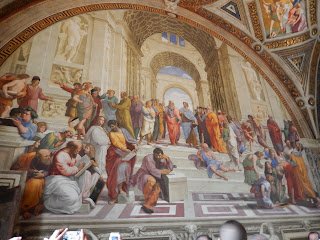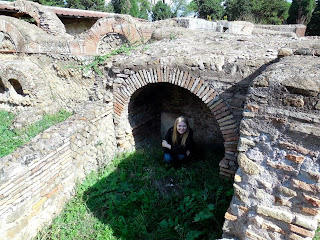After just one school day following my weekend in Matera, all thirty-four Smicks* boarded a coach bus bound for the Bay of Naples, a few hours' drive south along Italy's west coast. Dr. Portia Prebys - director of the program - three professors, and two bus drivers would accompany us on five days of touring one of the most well-known, picturesque, and historically important areas of Italy. None of us really knew what we were getting into; all we knew was how exhausted we were as our bus pulled away at 7:00am on November 5, and how annoying it was when our professors barked into a megaphone to tell us about the history of some piece of wall we were passing, when all we wanted to do was close our eyes and nap. But as soon as the signature double-crest of Mount Vesuvius came peering out of the morning fog, there was no time to sleep. We were here!
First glimpse of Vesuvio
We pulled into Herculaneum (modern Italian name: Ercolano) at about 10:30. Now, for those of you who haven't heard of this ancient city, you've likely heard of one of its neighbors: Pompeii. Both of these cities - and a few others, like Oplontis - grew up near the Bay of Naples in the shadow of Vesuvius, one of the most notorious (and yes, still active!) volcanoes on Earth. On August 24, AD 79, Vesuvius exploded in an cataclysmic eruption that devastated the surrounding area, burying Herculaneum and Pompeii in ash, lava, and superheated mud. The entire coastline was radically altered by the blast, and the cities remained buried until Pompeii was rediscovered in 1599 (Herculaneum, being much smaller, remained buried until the 1700s). Today, both cities (Pompeii in particular) are major touristic attractions because of how well the volcanic ash preserved everything from wooden doors to painted walls to skeletons.
Herculaneum
Since most of the Rome program is enrolled in Archaeology or Art History (or both, poor souls), much of our time in Herculaneum was spent giving and listening to presentations about various homes, buildings, and art decorations. There was something inexplicably eerie, though, to be wandering around the streets, touching the same stones and landmarks that the ancients touched...all under the shadow of the mountain that betrayed them. (There is simply no other way to put it; I've tried thinking of less dramatic language, but for me the moment was really that dramatic. It was incredible.) The most poignant moment, though, came right at the entrance. The city is below the level of the modern roads because of the meters and meters of ash that buried it, and at the edge - what was once the ancient coastline - is a stone arcade where ships would likely dock for the night. Inside the arcades is where the unlucky victims of Vesuvius spent their last moments, having made their way to the sea only to realize there was no escape. The skeletons have been left where they were found (or, at least, replicas laid in the exact positions and locations of the originals, which were moved for preservation and respect). It was a very personal encounter with the city, its inhabitants, and its demise that I was not expecting.
The ancient arcade
The bodies
After Herculaneum, we drove to the other side of the volcano to visit Pompeii. Many people who know me were undoubtedly aware of my excitement about seeing these ruins; since I was very young (like, elementary school) I'd been fascinated with the city, and visiting it had been on my bucket list since my first Latin class back in 2006. I also had my own Archaeology presentation to give, a five-to-ten minute speech about the Villa of the Mysteries, a sprawling country estate that had once housed wealthy families and a thriving wine business. But unfortunately - since daylight savings' had been a few weekends earlier - the sun was setting fast. We sped through the ancient streets with their signature "crosswalks" (see photo), cramming for a quick full-group photo in the odion (an ancient concert hall), crisscrossing the ancient Forum with Vesuvius brooding ominously in the background, coming face to face with plaster casts of ancient bodies in the Stabian Baths complex, giggling in front of the famous "Cave Canem" mosaic (below), and wandering the enormous expanse of the luxurious House of the Faun. All too soon for me, it was dark and we were leaving the city walls for a quick rendevous with the Villa of the Mysteries (I gave my presentation by the light of an iPhone...yeah).
Pompeiian crosswalks! (Wagon wheels could fit in the grooves while pedestrians didn't need to get their feet filthy with the muck and mud of the street)
Cave Canem: Beware of Dog
While excavating Pompeii, archaeologists found cavities in the hardened ash where corpses had decomposed and left their imprints behind. Since then, plaster has been poured into these cavities so that we can see the bodies of the volcano victims at the moment of death.
Very eerie.
We were staying in a hotel in Pompei (note the spelling difference between the modern Pompei and ancient Pompeii) that gave us a fantastic meal that compensated for the abysmal WiFi and rocklike mattresses. It had been a full day, so my friend Holly and I collapsed on our beds after dinner and did very little else until morning, besides take a cold shower and read some of A Study in Scarlet.
Vesuvius in the morning
The next morning we enjoyed a delicious and very European breakfast courtesy of the hotel: pastries, muesli, yogurt, ham, cheese, fruit, rolls, cake, and lots of options for caffè. Then we loaded once again onto the bus for a drive down the legendary Amalfi Coast. Known to packed during the summer, it was equally beautiful even on this November morning, the sunlight illuminating the electric blue water and the spectacular craggy cliffs plunging into the sea. Our route wound through impossibly tiny streets in the most charming Italian towns, their brightly colored buildings practically shining in the daylight. Ceramic roofs and walls - yes, ceramic roofs and walls - in particular captured my gaze; have you ever seen a ceramic church steeple?
Amalfi Coast
Ceramic church
Church of Sant'Andrea, Amalfi
Afterwards we found a cute little restaurant for a nice lunch up the hill (being right on the water, Amalfi climbs up the foot of the coastal "mountains") and settled in for a calm, relaxing afternoon of shopping and eating gelato...in true Italian fashion. It had been a very tiring few weeks for everybody, with early morning tours every Saturday and jam-packed weeks of studying, so there was nothing I would rather have done than spend a leisurely half-day in Amalfi. The air was warm and fresh and clean, the sky was brilliantly blue, the water was calm and sparkling with sunlight, and Amalfi itself was worth every bit of hype I'd encountered. (Plus, since it was off-season, the crowds were completely manageable, which made a tremendous difference.) I bought a little bottle of limoncello and a small ceramic replica of Pompeii's "Cave Canem" mosaic (since both ceramics and limoncello are typical exports of the Amalfi area).
In the last hour before the bus arrived to take us back to Pompei, most of the SMC girls made it down to the waterfront for some photos. As we sat on the dock, dipping our feet in the chilly Mediterranean, it seemed to me that for the first time we were all actually bonding. Of course, throughout our first month we had been making friends and enjoying adventures together, but mostly we'd been operating in small groups of friends that occasionally shifted and mixed. But now, it felt like we were all just enjoying each other's company as a big group, not smaller factions.
Maybe it's something in the water. :)
Maybe it's something in the water. :)
*Smicks: derived from SMC; Saint Mary's College students














































